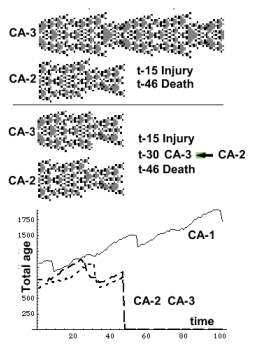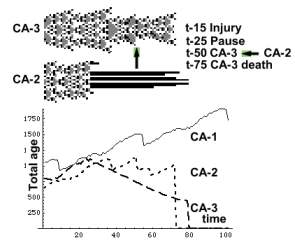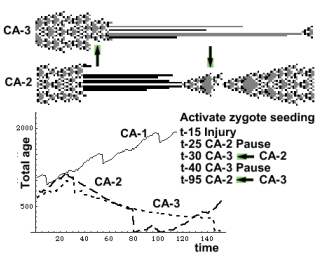 |
Information transfer
CA register
We continue to explore the properties
of the CA register . The proliferon consists of three processes (CA), a stem process
(CA-1) which keeps the
unit alive, and two transient processes. At t-15 CA-2 was injured.
Three of its border cells were removed, which ultimately killed it.
Apoptosis
Injury initiated a death process, called apoptosis, which extended
over 31 states. The next
experiment starts with the same injury. At t = 30 CA-3 copied the CA-2
state. Apoptosis was initiated, and soon CA-3 also died. The copied
structure was state 15 (30-15) of the apoptotic process, which
illustrates that any state of the apoptotic process, copied by CA-3
would have led to its death.
The copied states contain information for initiating
apoptosis . Unlike memories in conventional
computers our register does not store a description of apoptosis. It initiates it. Our memory does not store images
or data, but actions,
 |
 |
Forgetting
Memory is an active process which
requires resources (age). CA-2 may be rescued in two ways. Either it resumes accumulating age which will alter its structure, and it will
forget its apoptotic state-10.
Or it may get the required age from another process
. In the first case it will soon die from apoptosis. In the second case
it will remain frozen, and when activated it will also die from apoptosis.
The last experiment starts with the injury at t-15. At t-25
CA-2 stops aging and remains in apoptotic state-10 At t-30 apoptotic state-10 is copied to CA-3. It ages 10 time steps, which brings it to
apoptotic state-20. It now stores
this state till t-145. Meanwhile
CA-2 loses age and dies. It is replaced by a zygote. At t-95, CA-2 copies state-20 from CA-3 and soon dies to be
replaced by a zygote. Despite a change in the structure of state-20, it still induces apoptosis
in CA-2.
 |